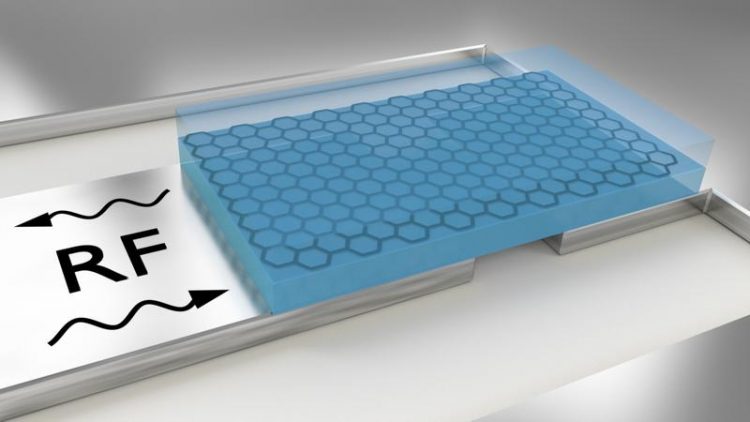New Method of Characterizing Graphene

The layer of graphene (black honeycomb structure) encapsulated in boron nitride (blue) is placed on a superconductor (gray) and coupled with a microwave resonator. University of Basel, Department of Physics/Swiss Nanoscience Institute
Graphene consists of a single layer of carbon atoms. It is transparent, harder than diamond and stronger than steel, yet flexible, and a significantly better conductor of electricity than copper. Since graphene was first isolated in 2004, scientists across the world have been researching its properties and the possible applications for the ultrathin material. Other two-dimensional materials with similarly promising fields of application also exist; however, little research has been carried out into their electronic structures.
No need for electrical contacts
Electrical contacts are usually used to characterize the electronic properties of graphene and other two-dimensional materials. However, these can significantly alter the materials’ properties. Professor Christian Schönenberger’s team from the Swiss Nanoscience Institute and the University of Basel’s Department of Physics has now developed a new method of investigating these properties without applying contacts.
To do this, the scientists embedded graphene in the isolator boron nitride, placed it on a superconductor and coupled it with a microwave resonator. Both the electrical resistance and the quantum capacitance of the graphene affect the quality factor and resonance frequency of the resonator. Although these signals are very weak, they can be captured using superconducting resonators.
By comparing the microwave characteristics of resonators with and without encapsulated graphene, the scientists can determine both the electrical resistance and quantum capacitance. “These parameters are important in the determination of graphene’s exact properties and in the identification of limiting factors for its application,” explains Simon Zihlmann, a PhD student in Schönenberger’s group.
Also suitable for other two-dimensional materials
The boron nitride-encapsulated graphene served as a prototype material during the method’s development. Graphene integrated into other materials can be investigated in the same way. In addition, other two-dimensional materials can also be characterized without the use of electrical contacts; for example, the semiconductor molybdenum disulfide, which has applications in solar cells and optics.
https://www.unibas.ch/en/News-Events/News/Uni-Research/New-Method-of-Characteriz…
Media Contact
All latest news from the category: Physics and Astronomy
This area deals with the fundamental laws and building blocks of nature and how they interact, the properties and the behavior of matter, and research into space and time and their structures.
innovations-report provides in-depth reports and articles on subjects such as astrophysics, laser technologies, nuclear, quantum, particle and solid-state physics, nanotechnologies, planetary research and findings (Mars, Venus) and developments related to the Hubble Telescope.
Newest articles

A universal framework for spatial biology
SpatialData is a freely accessible tool to unify and integrate data from different omics technologies accounting for spatial information, which can provide holistic insights into health and disease. Biological processes…

How complex biological processes arise
A $20 million grant from the U.S. National Science Foundation (NSF) will support the establishment and operation of the National Synthesis Center for Emergence in the Molecular and Cellular Sciences (NCEMS) at…

Airborne single-photon lidar system achieves high-resolution 3D imaging
Compact, low-power system opens doors for photon-efficient drone and satellite-based environmental monitoring and mapping. Researchers have developed a compact and lightweight single-photon airborne lidar system that can acquire high-resolution 3D…





















